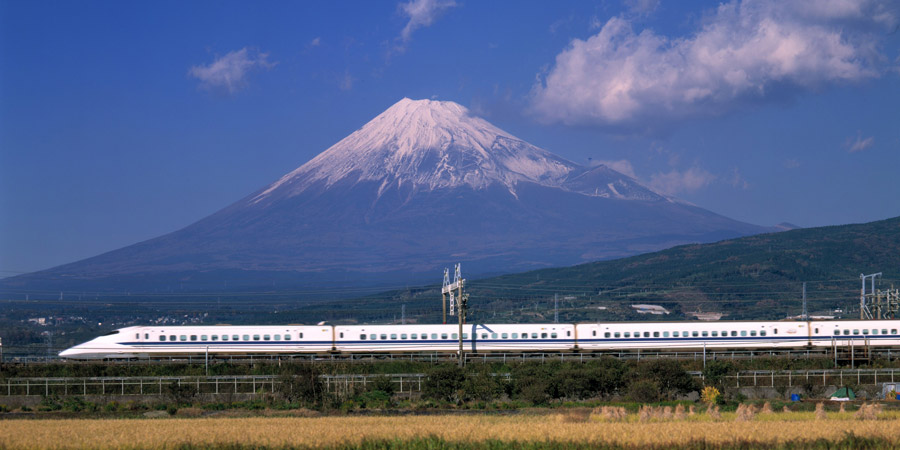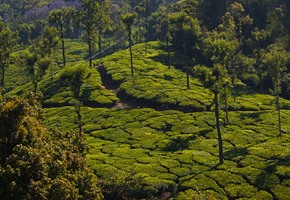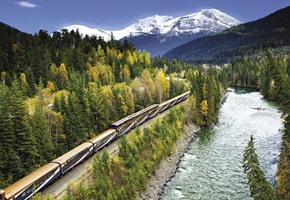Anyone well-versed in the endearing adventures of Tony Robinson thus far will be aware that he's bewildered an awful lot. Parisian cafe culture? Amusing. India's Toy Trains? Hilarious. A festival dedicated to a camping stove in the Australian outback? Well okay, we must admit that was pretty odd. But when it comes to the weird and the wonderful, there are few destinations that do it as well as Japan. Of course, Japan boasts an enormous amount of beauty; blush-pink cherry blossoms, serene and intricate temples, and beautiful snow-capped mountains rising out of verdant forests. But, there's a different side to Japan - a dazzlingly modern, eccentric, slightly offbeat side filled with neon lights, futuristic technology, and rainbow-hued street style.
"This is my first visit to Japan," says Tony, "so absolutely everything feels new to me." Tony is at his hotel, a traditional Japanese residence, and is explaining his first bout of culture shock. "I got to my hotel last night and the hotel manager insisted I wear this kimono-y thing. And then the shoe thing started." Tony explains that he must remain barefoot while inside and shows us a selection of the footwear he can utilise while at the hotel, including his 'toilet slippers', specifically for wearing in the bathroom. "Japan has done my head in," he declares, "and I haven't even got my shoes on yet!"
Tony touches upon some preconceptions surrounding Japan, explaining that just after World War II, the cruelty of the Japanese prisoner of war camps was infamous. But, he says, these days are behind us, and Tony wants to see how a new generation has shaped modern Japan. His first visit is to Beppu, unique for its location atop thousands of hot water springs, which means steam billows out of the ground. Residents here use the hot water to heat their homes, cook their cuisine, and even indulge in a treatment wherein they are buried in hot steam infused sand, which Tony samples and describes as a "sort of subterranean sauna."
Leaving Beppu, Tony begins his journey 1,200 miles north. He looks around the prestigious Seven Stars train, Japan's answer to the Orient Express and one of the most exclusive trains in the world, whose 30 passengers pay £10,000 a ticket. He's awe-struck; the interior is pristine, with elegant furnishings, an opulent bar and an opera soundtrack. Leaving the train, Tony crosses the platform to his somewhat more pedestrian train and continues to Kumamoto, where the samurai made their last stand against the Imperial Army 150 years ago. Although the samurai lost power in the 1800s, they still shape Japanese culture today, and Tony visits a master swordsmith for a lesson in the ancient art of swordsmanship. After a little training and words of encouragement - thoroughly lost on Tony who evidently doesn't understand a word of Japanese - he learns how to wield a sword to cut up a rolled-up bamboo mat.
Next, it's time for the Shinkansen. The Japanese bullet train is an enduring and iconic image of Japan, and Tony is impressed by its sleek exterior. "It's ultra-sophisticated and kind of sexy" he muses, "but inside, it's just a train. Bit disappointing really!" But this is a train that can reach speeds of up to 200mph, and it whisks him through the landscapes of Japan, covering 400 miles in less than three hours. Tony's heading to Kyoto but detours briefly to Wakayama, a town which has come up with an imaginative way to help its railway stay in business. It began when a local stray cat, Tama, was made an honorary stationmaster. The idea caught the attention of the public, and so the tradition has continued - the station is now home to a number of cats, as well as a Shinto shrine dedicated to Tama, making it a unique tourist hotspot. "It says something about the relationship between the Japanese and animals that I don't quite understand," says Tony.
Now in Kyoto, Japan's former Imperial Capital and the country's spiritual centre, Tony receives a lesson in meditation, learning that Japanese culture is heavily shaped by Buddhism. He says he's getting to grips with the politeness of society here, one which is described as sociocentric and focused on harmony, and he praises this approach.
Back on the bullet train, Tony heads to Tokyo, admiring a phenomenal view of Mount Fuji along the way. With Tokyo's energetic nightlife and eccentric street style, Tony isn't quite sure what to expect. He begins his explorations with a whistle-stop tour, which showcases the unique culture here - he buys a hot can of coffee from a vending machine, visits a capsule hotel, and encounters a taxi with self-closing doors. "I'm trying to make sense of the madness", Tony tells us, looked over by an enormous model of Godzilla. "It's an overwhelming assault on the senses." Next up, Tony delves into Japanese street style in Harajuku, a dramatic departure from "the suited salarymen" of the country. Harajuku is famous for its colourful, extravagant and unusual street style, and after a makeover ("quite liberating, actually") Tony visits a monster cafe, decorated in kawaii, or cute, style. Sitting down with some locals, he learns that this nonconformist subculture is popular with those who want to kick back against the traditional corporate life, comparing it to the punk movement of the 70s. Tony has one last thing to see in Tokyo - the world's first mascot school. Mascots are enormously popular in Japan, and this is a viable career choice for many - and an interesting one. Mascots, unlike the general population, are not encouraged to be reserved in public - they are overly animated, dance around, and wave at strangers.
Rebounding the bullet train, Tony is fascinated to discover that the seats can revolve 180 degrees so that passengers will always be facing in the direction of travel. Tony travels 200 miles to the coastal town of Sendai, then continues to Matsushima Bay, one of Japan's most scenic areas. His journey ends at Hakodate, the northern terminal of the bullet train, where Tony is reminded of the sheer size of this country. Unlike the sunny climes he enjoyed when he started his Japanese journey, here, the city is draped in a blanket of snow. This region is famous for its seafood, so there is perhaps no more fitting way for Tony to end his adventure than with an expertly prepared sushi lunch.
Reflecting upon his time here, Tony says that Japan has "felt very foreign to me, and there's still part of the country that I can't get my head around. I don't know if I'll ever understand the dressing up and the love of all things cute." But, he says, "talking to Japanese people, I've learned how hard this society works to be harmonious in everything, and I admire that."




